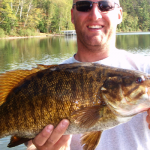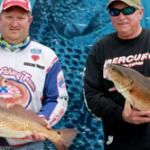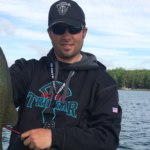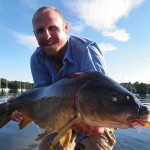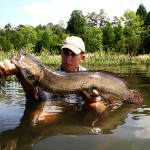By: Todd Wendorf and Collin Venn – Date Posted: September 15, 2011
As the fall leaves turn beautiful shades of brown, orange, and yellow, fish of the same colors begin to invade the shorelines and tributaries of Lake Michigan. After spending the summer in the areas of the lake only reached in a good sized boat, the “brown beasts of fall” are well within reach of every angler by the early days of October.
The two strains of brown trout that are prevalent throughout Lake Michigan are the Seeforellen and German browns. Their spawning migrations begin as soon as king salmon are concluding theirs. As a result, by the time the browns get into the marinas and tributaries along the coast lines, the water is filled with spawn and decaying salmon. Everything in the ecosystem feeds off of the eggs and carcasses of the now spent salmon.
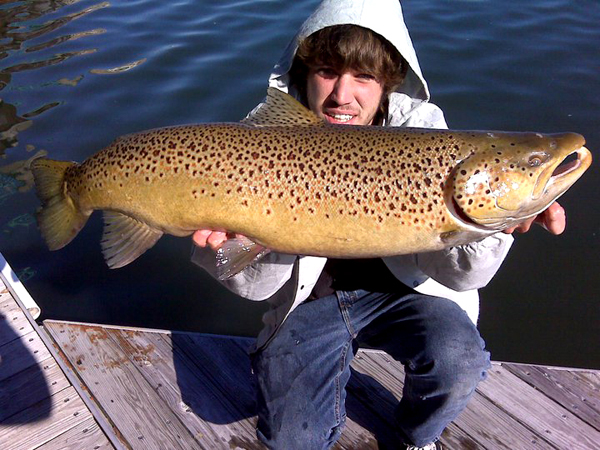
We’d like to share with you two distinct approaches to catching fall-run browns: Fishing spawn under floats, and fishing hard baits, including spoons, plastics, crank baits, lipless cranks, and others. In doing so, we will also provide you with play-by-play narrative of two monster fish we caught last fall in the same spot using two totally different methods.
Fishing fall-run browns with spawn is both simple and complex. It’s really not much different than soaking a worm under a bobber for panfish. You simply hook a thumb nail sized spawn sack on a #6 octopus hook (I prefer Gamakatsu), add a float and a few sinkers and you’re all set to go! Stay as small as possible with each component to reduce the amount of resistance fish feel when tasting and eating the bait. I fish with 10 lb test monofilament main line and a 24” 12 lb fluorocarbon leader, all attached to a 3500 to 4000 series reel (with at least 7 ball bearings) and a 10 ft. 6 in. St. Croix Wild River steelhead rod.
Now the complex part is finding fish and convincing them to eat your spawn.
The river system is filled with spawn from salmon that have completed their spawning cycle. Salmon spawn is obviously a targeted food source during the early stages of fall. Later, as the salmon spawn deteriorates and disappears, browns will turn to the spawn of other brown trout that have also moved into the system to drop their eggs. As such, when targeting browns you’re usually best off using brown trout spawn sacks. Sacks can be fished fresh or cured. Curing with a product like Pautzke’s BorX O Fire keeps spawn firm and colorful. It also adds a scent attractant (krill) into the water. You’ll find that cured sacks won’t milk out nearly as fast as fresh ones, allowing you to use them for a longer period of time before changing.
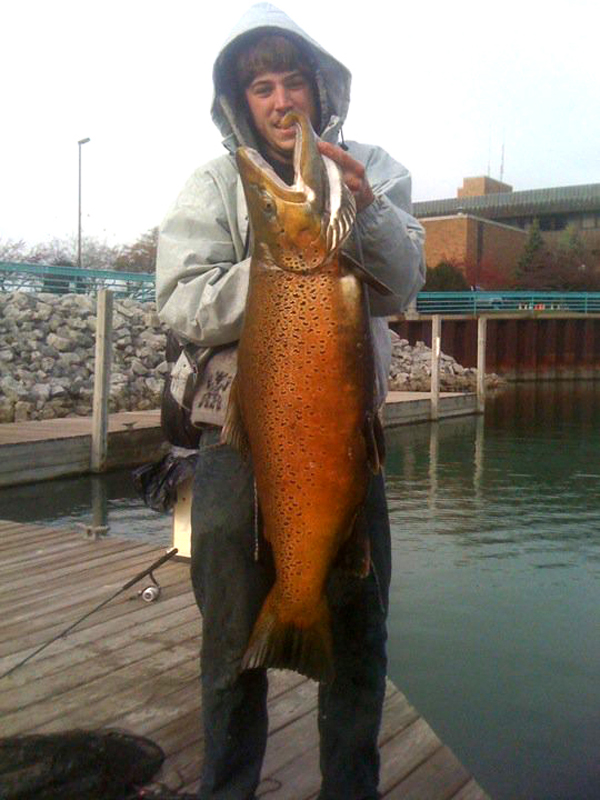
Locating Browns is somewhat difficult in that you usually can’t sight-fish them like you can spring-run steelhead. The tendency of the fish to spend much of their time in the deeper areas of marinas and rivers and the fact that the water is often murkier in the fall make this all but impossible. However, if you remember one simple principle, you can often locate migrating browns. Look for current!
Todd’s Account:
The morning of October 17, 2010 started out rather slow. After a two hour drive, and arriving at the marina by 6:00 a.m., I waited two hours for my first bite of the day. After a 5 minute battle an estimated 15 lb. king salmon made one more violent run and snapped my leader. The fact that the dark, male salmon was lost didn’t really bother me as I got a good fight out of it and would have released it anyway. Unfortunately, that was the last bite for the next 4 hours.
About the time I was about to pack things up and move to another location I saw what appeared to be a small school of dark bodied fish moving along the edge of a set of boat slips and headed in my direction. It was quite obvious the fish had one thing in mind; the current being produced by the pump located to my right. The fish moved under the dock closest to me and out of sight. I knew they were under there … just didn’t know exactly where. Like a steelheader fishing a run, I repeatedly tossed my float toward the pump and allowed it to float parallel to the dock the fish had to be under. Within about 5 minutes an average sized brown darted out, grabbed the sack, and broke me off on a dock post, all in one swift motion.
As I was retying my float rig I saw numerous fish swim out from under the dock and then back in. I let them settle down and then tossed my float toward the pump. Near the end of the drift the float went down again. I set the hook with the long rod and the fish immediately rolled and headed to deeper water at the end of the slip. After a 10 minute fight my new friend Damien landed what we both figured to be a nice king, only to be shocked at the 23” girth of a 31”, 20.5 lb. female brown trout.Typically in late fall we’re fishing with spawn as mentioned, but we also find success casting lures. Crankbaits really shine this time of year. Thundersticks, Husky Jerks, and X-Raps are some fine choices and what I keep my boxes stocked with. When you’re fishing baits like the Husky Jerk, you’re going to want to make long casts and really work the bait back hard on most days. Don’t be shy. Rip the bait 6 ft. then come to a dead stop and repeat the process.
Often times, brown trout will try to rip the rod out of your hands. On bright sunny days, small minnow type baits like the orginal Rapala just casted out and slowly cranked back in are worth using. Don’t completely forget about spoons either as they can really have their days. This time of year it’s the smaller spoons that usually do the damage. Spoons at 2/5 oz. to ¼ oz. are typically on the menu but we downsize to 1/8 oz. some days. Colors can matter too, but it’s never a bad thing if it has some chartreuse on it.
When casting cranks this time of year we’re using a 10 ft. medium /light action rod and a 2500 series Shimano reel spooled with 8 lb. monofilament. The longer rod gives me the ability to work the lure more and it also helps in setting the hook when the fish hits at the end of the cast. It works wonders when jig fishing as well. Jigs and plastics can be killer. Small panfish sized jigs all the way to 4 in. Gulp Minnows work. You typically fish jigs one of two ways. The first, and most obvious, is to cast it out and slowly pop it back in. Another is to attach a small bobber a few feet above the jig to suspend it as you work it back in. This allows you to move the jig as slow as needed to provoke a hit from a hungry brown trout. On days when they’re finicky, a slow presentation is a killer!
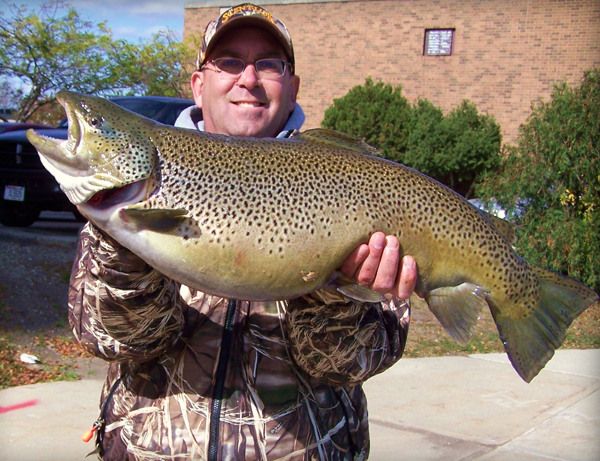
Collin’s Account:
Coincidentally one month after Todd caught his giant I got my shot at one and I took it. The day started out slow with only a few fish caught between a few anglers accompanying me. As one of my partners was leaving he called me and said he had just seen the two biggest brown trout he’s ever seen swimming near the aeration pumps. These happened to be the same pump Todd’s 20 pounder came from. I took his advice and decide to investigate.
Here I was, practically on tip toes trying to avoid spooking any potential fish. As I crept closer I didn’t see anything. “Man I’m too late, they’re already gone”, I thought. “Oh well, I might as well make a few casts anyway”. I made a few short pitches around the pump with a small jig. Nothing. Nada. At this point I decided to head back towards my friends. I took about ten steps back and I saw them. Two of the biggest brown trout I’ve ever seen in my life. My heart was racing. I pitched my lure in front of them, pop, pop, pop. The jig swam in front of their noses and not even a sniff. I made another cast and this time it came up short. My line bumped into one of the fish and … poof, they disappeared.
I sank down on the pier. “There it was Collin, your chance and you messed it up.” I kicked myself for it. Just as I started walking away I saw them again. “Here it is now … this is your last shot make it happen”. I cast my Little Cleo back towards them, jigged it twice, and just as my lure got to within striking distance the larger of the two turned on it. He’s got it! I set the hook and immediately knew this wasn’t your everyday brownie … this was heavy! I couldn’t even turn it as it continued on its way like nothing really happened. The fish was clearly upset and was surrounded by pilings and docks. I yelled to my friend, “Grab the scoop and hurry … you’ve got to see this thing before it breaks me off”. At that point I was convinced I was going to lose it so I was just taking in the moment.
My friend came running up and his jaw dropped as soon as he saw it. Now it’s game time! Let’s get this thing in the net. The fish began digging underneath the pier and I did my best to muscle it out using every inch of my 10 ft. rod for leverage. It was brought in closer and Joe seized his chance. Elbow deep in the water he went. It’s in the net!
My friend laid passed out on the pier, chest down, hanging half way over the edge of the pier with both hands on the net. The monster brown was obviously way too large for that net, and I stood there with my jaw on the pier at the sight of the thing. Then reality hit when Joe yelled, “What are you doing? Help me get this thing on the pier. I can’t lift it by myself!” I helped him with the net and there, in front of me, was a 43” monster of a brown trout.
I knew right away I wanted to release the fish. Every second counted as we had to get this guy back in the water. We took a few pictures, then released what was undoubtedly the fish of a lifetime back to his home.
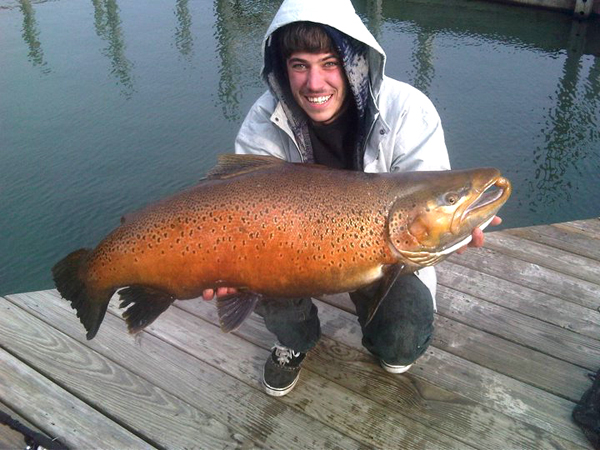
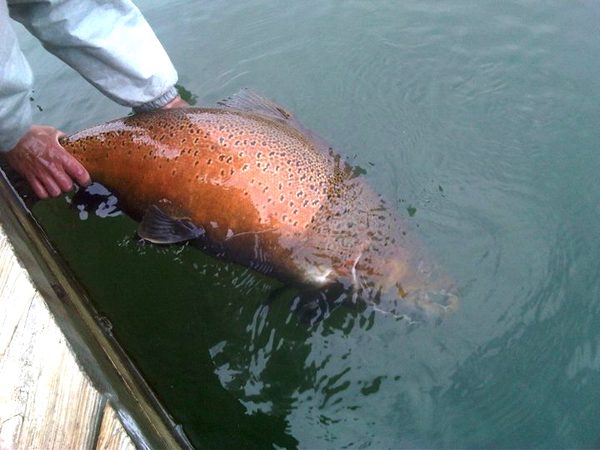
Unlike salmon, brown trout do not die after laying their eggs. They can live for many years. We’ve seen with two world record fish in the last few years come out of Lake Michigan. Releasing these fish today will allow this world class fishery to continue to flourish and will allow more fishermen to enjoy their opportunity to battle one of the brown beasts of fall.
Todd Wendorf grew up in Northern Wisconsin and now calls McFarland, WI home. He is an avid bass fisherman who specializes in shore fishing, wading, float tubing, and kayak fishing. When not chasing big largemouths, Todd frequently fishes for steelhead and brown trout in Southeastern Wisconsin harbors & tributaries. You can visit Todd online at http://www.needtofishmore.blogspot.com/




